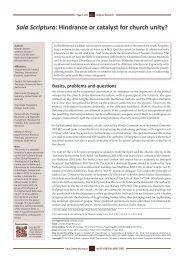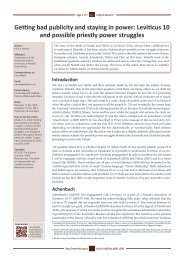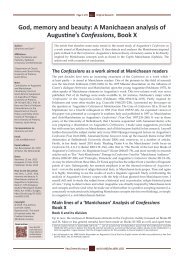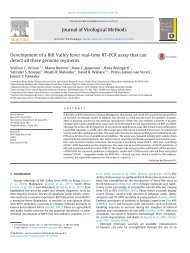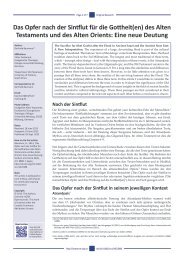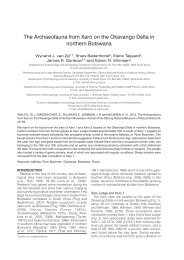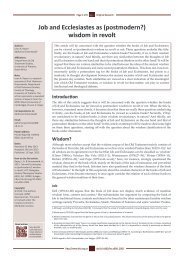THE PSALMS AS HYMNS IN A LITURGICAL CONTExT 1
THE PSALMS AS HYMNS IN A LITURGICAL CONTExT 1
THE PSALMS AS HYMNS IN A LITURGICAL CONTExT 1
You also want an ePaper? Increase the reach of your titles
YUMPU automatically turns print PDFs into web optimized ePapers that Google loves.
Original Research<br />
Vos<br />
Article #105<br />
HTS Teologiese Studies/Theological Studies<br />
association between the Old Testament and various psalms,<br />
while the spirituality is revealed of the group that prayed and<br />
meditated on these psalms (Zenger 1997:28; Leuenberger 2004;<br />
Vos 2005:44-49).<br />
Many of the titles suggest the musical form a psalm should<br />
take. Indications are also given of the melody in which a psalm<br />
should be sung. The melodies of known folk songs were used<br />
as a basis (Zenger 1997:28-29). The melody, “(D)eath of a Son”,<br />
can be linked to Psalm 9, and Psalm 57 was sung to the melody of<br />
“(D)o not Destroy!” Directions are also given for the instrumental<br />
accompaniment, e.g. “with stringed instruments” (Ps 4), “with<br />
flute” (Ps 5) and “on an eight-stringed harp, with bass voice”<br />
(Ps 6). It is supposed that the compiler did not mean these<br />
indications to be technical directions. The directions for Psalm<br />
6 indicate that the psalm was prayed/sung by those who were<br />
longing for the messianic times and, according to the rabbinical<br />
tradition, the eight-stringed harp was the instrument of these<br />
times (Zenger 1997:29).<br />
Other titles suggest either the real, or the merely fictional cultic<br />
use of a psalm. Psalm 30 is recommended “for the dedication of<br />
the temple,” Psalm 92 “for the Sabbath day” and Psalm 100 “for<br />
thanksgiving.” Such would be the directions for the real use of<br />
the psalms in the cult of the Second Temple, especially because it<br />
is more likely that the psalms originated from other situations in<br />
life (Zenger 1997:30; see also Groenewald 2003:148, 270). These<br />
headings therefore indicate a change in “Sitz im Leben”.<br />
In most cases, the titles of the psalms refer to the names of the<br />
groups or individuals to whom the psalms were connected.<br />
A psalm is linked to David 73 times, 12 times to Asaph (a<br />
prominent Levite of the post-exilic period, for whom a guild<br />
of temple musicians is named), twice to Solomon, four times<br />
to the Jeduthun, and once to Moses, Heman and Etan (Zenger<br />
1997:30; see also Jonker 2004:103-113). “The sons of Korah” and<br />
“for the sons of Korah” could be understood as meaning a psalm<br />
from the collection of the sons of Korah. However, the mention<br />
of Moses or David was intended as an editorial indication and<br />
explanation only; it was not intended as historical information.<br />
The supplicant should be able to imagine how and why this<br />
psalm (Ps 90) was prayed by Moses or David, because of the<br />
allusion in line 3 to Genesis 3:19. The supplicant should then also<br />
be able to pray the psalm with Moses or David in communal<br />
prayer (Zenger 1997:30).<br />
In Chronicles, David is neither a supplicant nor a singer of psalms.<br />
He is the founder and organiser of the temple music, probably<br />
even the inventor of instruments, as well as the commissioner<br />
for the writing of psalms and their setting to music (Braulik<br />
1995:69; Zenger 1998:41). The David of the psalms (with the<br />
exception of Psalm 30) does not stand in any liturgical context.<br />
On the contrary, his feet are firmly on the ground, as he is both<br />
a victim of persecution and a sinner. He is also someone who<br />
is threatened by enemies and is then saved from them. In the<br />
psalms, he clings to God. The psalms are not concerned with his<br />
official duty as king; instead David is depicted as a figure with<br />
which to identify: “as David, so every man” (Braulik 1995:71;<br />
Zenger 1998:41). (On David as an integration figure, see Millard<br />
1994:230-234; cf. also Kleer 1996; Leuenberger 2004:172-206;<br />
Schuman 2008:162-165.)<br />
The psalms linked to David’s name make up a collection. These<br />
psalms have “biographical” titles and, especially in the Books of<br />
Samuel, they are so intertwined with narratives that they are cast<br />
in a narrative mould (Zenger 1998:41).<br />
Psalms 50 and 73-83 are associated with Asaph. In these psalms,<br />
the accent is on divine judgement, the divine oracles and an<br />
appeal regarding God’s actions in the past. This all points to a<br />
prophetic background and reference can be made to 2 Chronicles<br />
29:30; 1 Chronicles 25:1-6 and to the sons of Korah (Ps 42-49; 84-<br />
88). These psalms originated in the Jerusalem cult and the many<br />
references to Zion are clear proof.<br />
There is no doubt that the titles of the psalms were added to<br />
the texts later, as they reflect the historical conscience of the<br />
redactors of the psalms, rather than the historical foundation.<br />
The titles also serve to bind groups of psalms together where<br />
communal theological concepts can be distinguished (Zenger<br />
1998:27). It has only been a few years since psalm scholarship<br />
acknowledged the fact that the canonical Psalter is the result of a<br />
complex process of collection as well as redaction. The attempt to<br />
explain the present shape of the Psalter is thus a relatively recent<br />
endeavour. Currently, the final form of the book of the psalms<br />
receives more attention and the idea of a somewhat haphazard<br />
arrangement has been questioned. Thus, interest in secondary<br />
settings of the psalms, including the literary context of the book<br />
as a whole, has increased. The emphasis of the reading is thus<br />
not on the individual psalm alone, but has shifted to a canonical<br />
reading of the individual psalm, i.e. on its respective position<br />
in the Psalter and, especially, the significance of its position for<br />
its interpretation (Hossfeld & Zenger 1993:166-182; Schuman<br />
2002:36-39; cf. also Groenewald 2003:277).<br />
The psalms as hymns<br />
The Book of the Psalms is the sanctuary where God is praised and<br />
from where his blessing is given. It in no way replaces the temple<br />
or the cult but instead represents an encounter with Yahweh<br />
residing in his temple on Zion as king of both Israel and the whole<br />
world (cf. Zenger 1998:47; Berges 1999:15).<br />
There are three theopoetical ways to speak to God in the psalms:<br />
via the lament, the prayer or in praise (Spieckermann 2003:137;<br />
Gerstenberger 2003:76; see Schuman 2008:48-52 on the Psalms as<br />
a book of hymns). In Hebrew translations of the psalms, praise<br />
is distinguished contextually, but not semantically (Westermann<br />
1977:20-28). We can find idioms in direct and indirect speech in<br />
the Psalms. There are also the actions of speech such as accusation,<br />
trust, self-reflection, the giving of praise to the king and to other<br />
people and so on. The three actions of speech, however, form the<br />
core of the psalms (Spieckermann 2003:137).<br />
Praise in the hymns follows different patterns (Spieckermann<br />
2003:137). There are hymns which call for praise by naming the<br />
supplicant and giving reasons for the praise (Psalms 100; 148).<br />
There are also hymns which make use of participia to describe<br />
God’s nature (Ps 104; 147).<br />
An entire anthropology is embedded in some of the hymns and is<br />
directed towards the praising of God (cf. Ps 8 and 103) (cf. Irsigler<br />
1997:1-44 on Psalm 8; cf. also Strauß 2003:17-23). Psalm 23 is a<br />
psalm of trust and is woven with a delicate hymnal thread. Even<br />
the prayer of lament ends in praise (Ps 13). The hymnal function<br />
in the psalms of lament can be clarified with two examples. In<br />
Psalm 22 – an individual psalm of lament – verses 4-6 have the<br />
function of creating an antipode to the lament. In this manner,<br />
the individual history of suffering is inserted into the history of<br />
trust and the salvation of Israel. In Psalm 74 – a people’s lament –<br />
the hymnal core, verses 12-17, creates hope after the catastrophe<br />
of 587–586 BCE by uniting with the temple theology of Jerusalem<br />
(Spieckermann 2003:138).<br />
In the fourth and fifth Book of Psalms (Psalms 90-106; 107-150),<br />
the hymnal formulas and hymnal-woven text compositions<br />
increase (Zenger 1997a; Kratz 1996; Spieckermann 2003:142).<br />
The psalm-group 90-100 is a hymnal group, which celebrates the<br />
universal kingship of God. Psalm 96 deals with the question of<br />
how nations are expected to attain salvic knowledge. In Psalm 96,<br />
it becomes clear that it is expected that Israel’s worship will have<br />
a particular effect on the nations (Psalm 96:1-4). Again, we notice<br />
the basic form of the hymn: imperative, addressee, vocative and kî<br />
(verses 1-4). However, the imperatives are liturgical only in part<br />
(three repetitions of “sing”). They are followed by verbs, which<br />
characterise the form of speech usually directed at people outside<br />
the community of worship.<br />
The poem refers to a messenger of victory, who informs people<br />
that do not know about the positive outcome of a battle, about<br />
2 HTS<br />
Vol. 65 No. 1 Page 2 of 6<br />
http://www.hts.org.za



